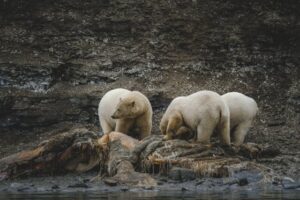Physical Address
23,24,25 & 26, 2nd Floor, Software Technology Park India, Opp: Garware Stadium,MIDC, Chikalthana, Aurangabad, Maharashtra – 431001 India
Physical Address
23,24,25 & 26, 2nd Floor, Software Technology Park India, Opp: Garware Stadium,MIDC, Chikalthana, Aurangabad, Maharashtra – 431001 India

By Aayushi Sharma
Recently, a tragic incident unfolded at a remote radar site on Brevoort Island, Nunavut, when two polar bears fatally attacked an employee. The unnamed worker was part of Nasittuq Corporation, which operates several Arctic radar sites for the Canadian government. The company confirmed the death on Friday, describing the event as a “tragic incident.”
This devastating attack is a stark reminder of the growing dangers posed by climate change in the Arctic. As the polar bear’s natural habitat diminishes, these majestic yet formidable creatures increasingly encroach on areas where humans operate. The shifting range of polar bears, driven by melting ice and altered food availability, has led to more frequent and sometimes deadly encounters with humans in recent years.
Records show that reports of polar bear attacks on humans used to be extremely rare. According to a 2017 study by The Wildlife Society, ‘From 1870-2014, 73 attacks by wild polar bears were documented, distributed among the 5 polar bear Range States (Canada, Greenland, Norway, Russia, and United States), which resulted in 20 human fatalities and 63 human injuries.’
Polar bear numbers were significantly lower during the mid-20th century than they are today. This was not due to climate change but rather the result of unsustainable hunting practices. During the 1950s and 1960s, polar bears were hunted extensively across their range, leading to a drastic reduction in their numbers. By the 1980s, it became clear that without intervention, polar bears could face extinction.
In response to this crisis, countries within the polar bear’s range, including Canada, Russia, Greenland, Norway, and the United States, implemented strict hunting regulations and, in some cases, outright bans. These efforts were largely successful, and polar bear populations began to recover. By the early 21st century, the global population of polar bears was estimated to be between 22,000 and 31,000, a significant increase from the mid-20th century low.
The On-going Threat: Climate Change
Despite the recovery in population numbers, polar bears now face an even more daunting challenge—climate change. Unlike the threat of hunting, which could be mitigated through regulation and enforcement, climate change is a global phenomenon with far-reaching consequences. The Arctic, where polar bears are found, is warming at a rate nearly four times faster than the rest of the world. This rapid warming is causing the sea ice, which polar bears depend on for survival, to melt at an alarming rate.
The Arctic sea ice is crucial for polar bears as it serves as a platform for hunting, breeding, and, in some cases, denning. Polar bears primarily hunt seals, particularly ringed seals, which they catch from the ice. The seals’ blubber provides the high-fat content necessary for the bears to maintain their energy in the harsh Arctic environment. The most critical hunting period for polar bears is late spring and early summer when seals are abundant on the ice. As the ice melts earlier in the season and forms later, polar bears have less time to hunt and build up the fat reserves they need to survive.
The Impact of Melting Sea Ice
The loss of sea ice has several cascading effects on polar bears. Firstly, with less ice available, polar bears are forced to travel greater distances to find food. Polar bears spend over 50% of their time hunting for food. This increased exertion requires more energy, yet the bears have less access to their primary food source. Studies have shown that polar bears are losing weight and body condition as a result, which can lead to lower reproductive rates and higher mortality, particularly among cubs.
Secondly, as the ice melts, polar bears are spending more time on land, where food is scarce. While polar bears can survive on land-based food sources such as berries, birds, and even human garbage, these foods do not provide the high-fat content that seals do. This shift in diet can lead to malnutrition and further reduce the bears’ ability to reproduce and survive.
The shrinking sea ice also forces polar bears into closer proximity with human populations, leading to an increase in human-bear conflicts. In some Arctic communities, polar bears have been reported scavenging in garbage dumps or approaching homes in search of food. These encounters can be dangerous for both bears and humans and in some cases, have led to the bears being killed in self-defense.
The Future of Polar Bears in a Warming World
The future of polar bears in a warming world is uncertain. Scientists have projected that if current trends continue, two-thirds of the world’s polar bear population could disappear by the end of the century. Some populations, particularly those in the southernmost regions of the Arctic, could face extinction within the next few decades.
Efforts to mitigate climate change and reduce global greenhouse gas emissions are crucial to slowing the loss of sea ice and giving polar bears a chance at survival. International agreements like the Paris Agreement, which aims to limit global warming to well below 2°C above pre-industrial levels, are essential in this regard. However, even if these targets are met, significant warming in the Arctic is still expected, and polar bears will continue to face challenges.
In addition to global efforts to combat climate change, conservation strategies that focus on polar bears specifically are also needed. These could include protecting critical habitat areas, managing human-bear conflicts, and conducting further research into the impacts of climate change on polar bears.
References:
2 polar bears kill worker at remote Nunavut radar station
https://www.theguardian.com/world/2024/feb/13/polar-bears-risk-starvation-arctic-ice
https://www.worldwildlife.org/species/polar-bear
https://polarbearsinternational.org/polar-bears-changing-arctic/conservation-concerns
Image:
Photo by Francesco Ungaro https://www.pexels.com/photo/three-polar-bears-by-river-26755457/
Comments are closed.
Hello climatefactchecks.org admin, Thanks for the in-depth post!